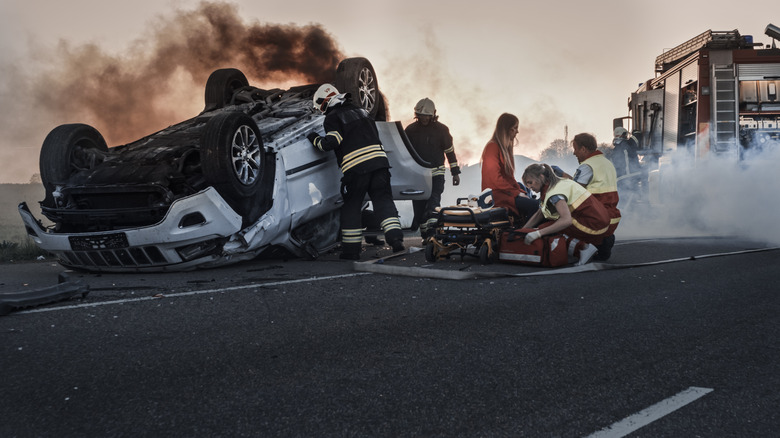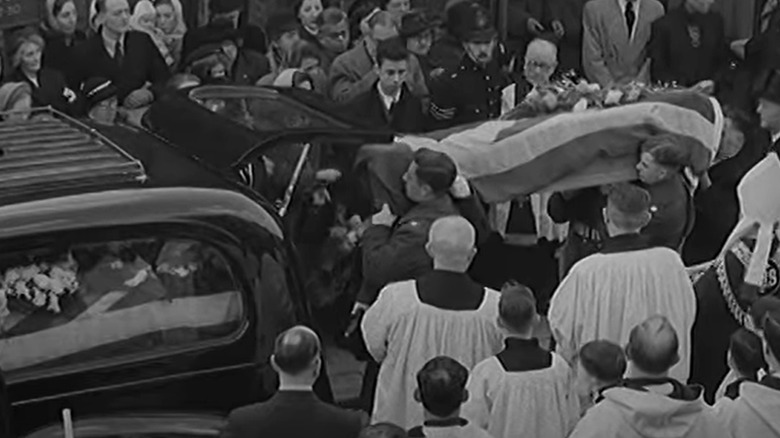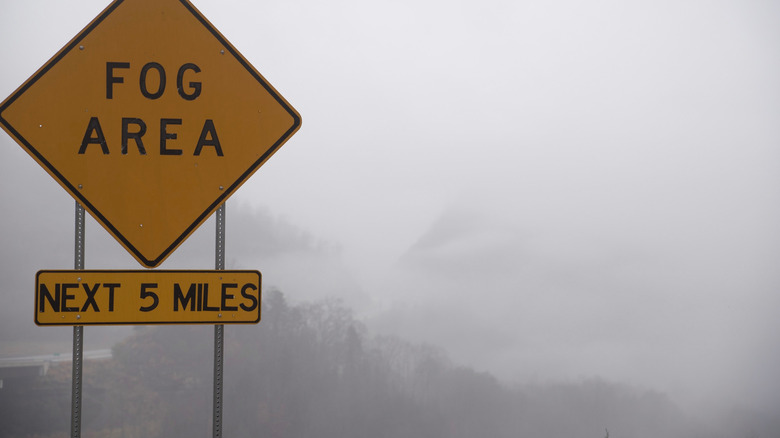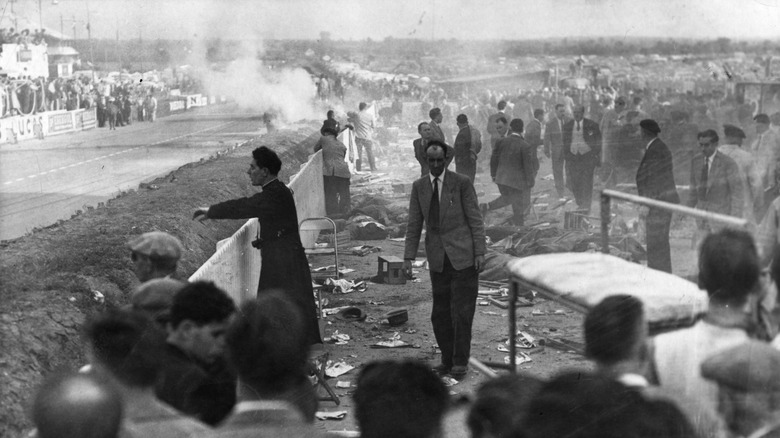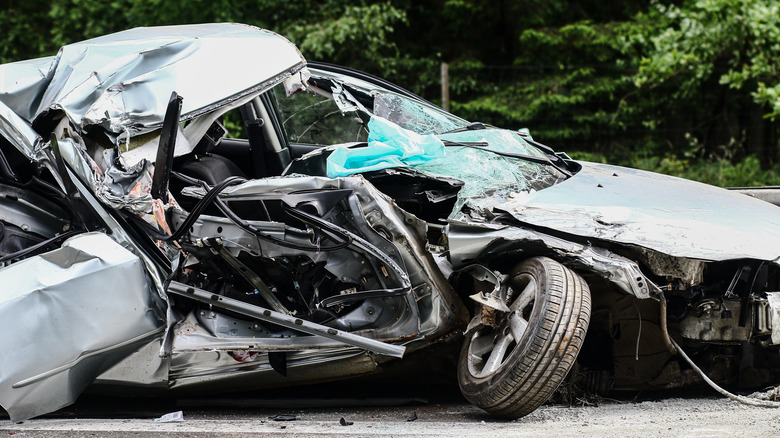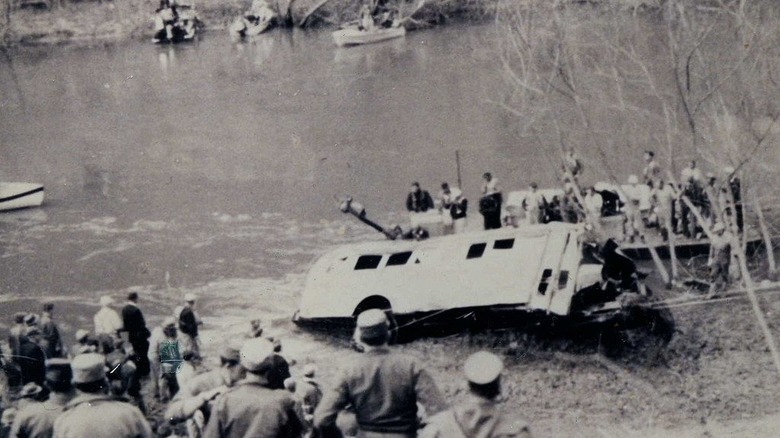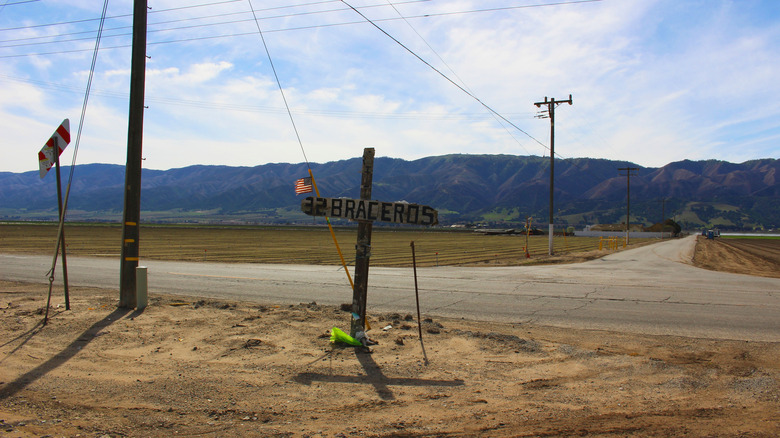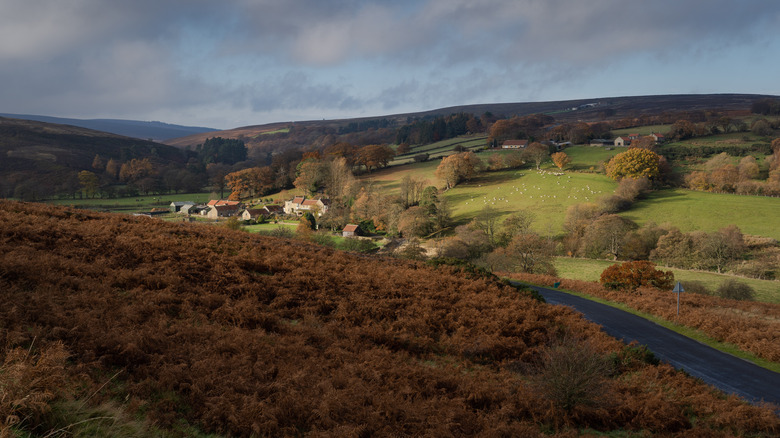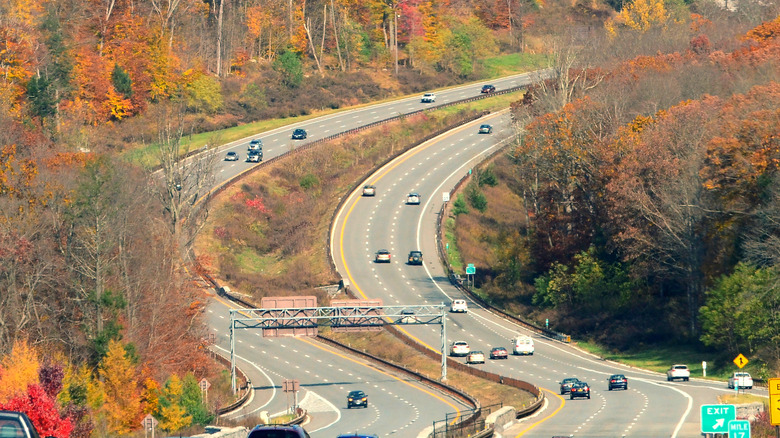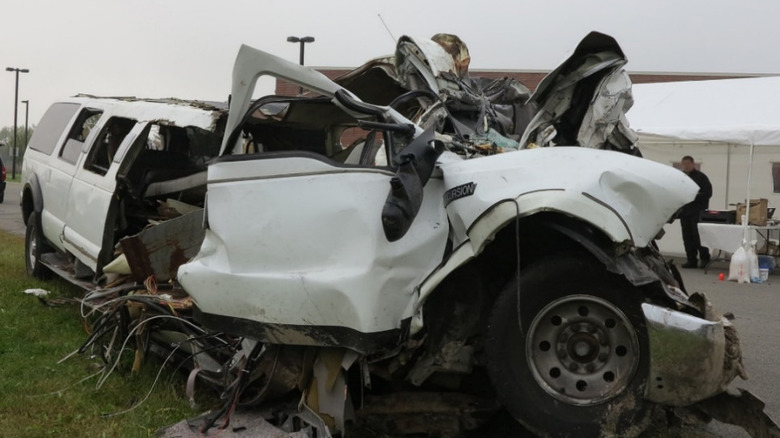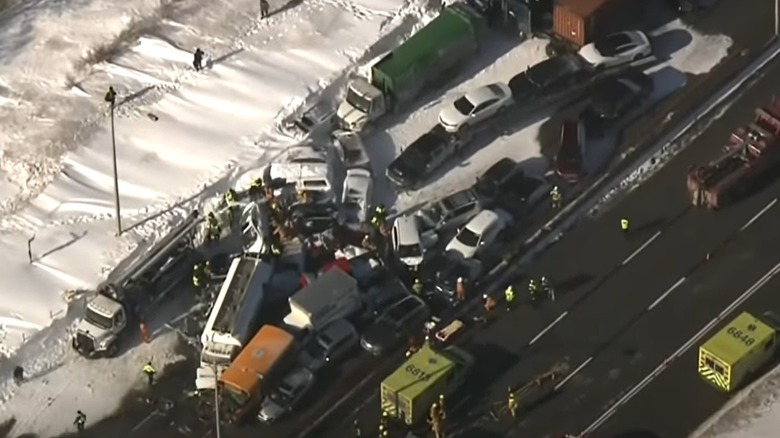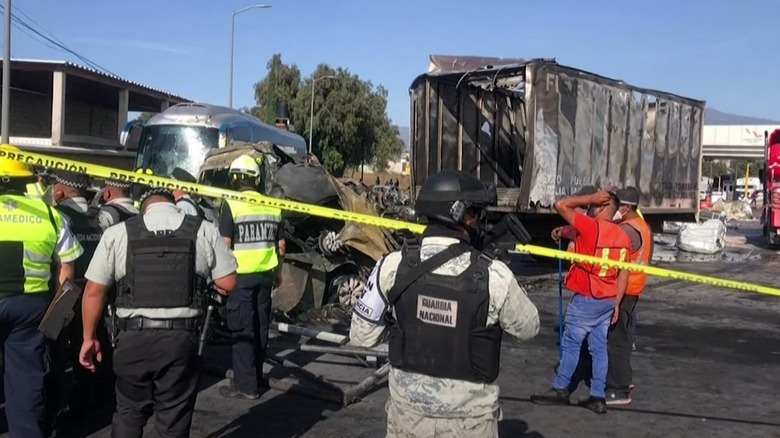The Deadliest Car Crashes In History
While it is true that most motor vehicle accidents do not result in fatalities, those that do can often be dramatic. Car crashes form the basis of modern nightmares, featuring severed limbs, high octane explosions, and uncontrolled cars hurtling down cliffs. But these nightmares are sadly too often the stuff of visceral reality. Some of these lethal tragedies are notable for the incredible number of lives that they took. Yet, are mass fatalities on the road a thing of the leaded-fuel era? Have roads become safer than they were in the past? Not necessarily.
According to National Highway Traffic Safety Administration, the first half of 2021 showed the largest percentage increase in motor vehicle fatalities since 2006 with over 20,000 fatalities on America's roads. The U.S. Department of Transportation secretary Pete Buttigieg said, "This is a crisis." This rise in automotive fatalities probably correlates to drivers indulging in more dangerous habits during the pandemic such as speeding and not wearing safety belts.
So be sure to buckle your safety belts and make sure your airbags are fully operational as we careen down the tragic road of looking at a selection of some of the deadliest car crashes in history.
Salem, Illinois, March 25, 1937
Roller derby first came into fashion during the Depression as endurance races on wheels for cash prizes. While the Smithsonian Center for Folklife & Cultural Heritage tells us that at this stage, roller derbys were less boisterous than they were to become, they were nevertheless gaining in popularity.
So what does roller derby have to do with car accidents? The popularity of roller derby led to the development of teams that would travel to various competitions across the country. One such team was traveling by bus on route 50 from St. Louis to Cincinnati on March 25, 1937, when disaster struck. One of the bus' tires blew out while it was heading downhill. The driver, Dick Thomas of Chicago, lost control and veered the vehicle into a bridge abutment. The bus struck the abutment so hard that the engine was hurled out of it. The vehicle immediately erupted into an inferno. The New York Times reported that witnesses saw 40 foot jets of flame leap into the air. One man's clothes even caught on fire as he was hurled through the bus' window. As for those trapped inside, there was little that could be done. Of those aboard, 18 were killed, including a 4-year-old child. The New York Times also reported another six fatal injuries, though it is unclear if those victims were bystanders. There were five survivors, which included the bus driver.
Gillingham, United Kingdom, December 4, 1951
On the night of December 4, 1951, in Gillingham, Kent, in the United Kingdom, a column of cadets marched along an unlit section of Dock Road. They were heading from their base to the Royal Naval Barracks. According to Kent Online, these were boys between the ages of 9 and 13. While the rigors of cadet life were no doubt daunting, it could in no way prepare them for the tragedy to come.
As the boys were marching, John Samson was driving a double decker bus down the road. Samson himself claimed to be driving between 15 to 20 miles per hour. However this seems unlikely, since Samson plowed into the column. 24 boys were killed and another 18 injured. None were injured on the bus.
The tragedy reached a national scale. The Independent reported that King George and Winston Churchilll sent condolences to the victims' families, and Parliament investigated the matter. In 1993, a memorial was erected for the victims. As for Samson, he was fined but not given jail time. The justice stated, "You are a man of good character ... it would be absurd to send you to prison. Everyone who has heard this case feels the greatest sympathy not only with the parents and relatives of these unfortunate children but also with you." Samson never drove again.
Pine Mountain, Kentucky, July 31, 1954
On July 31, 1954, 12 people were jammed into a 1941 Buick and traveling over Pine Mountain in Kentucky. The people in the car were a combination of two families, who were, as reported by the Mountain Eagle, heading on a short drive from Milestone to Linefork for the husbands to "show their wives where they worked."
The Medford Mail Tribune (via Gendisasters) reported that as the car crested the long winding road over the mountain, the brakes gave way. The driver, Tom Brown, then deliberately ran the car into a ditch to slow it down. It sideswiped a cliff and ricocheted over the curve to the opposite side of the road where it ran into the cliff face and flipped on its side. The collision itself was not the deadly part. What made the crash most fatal was that the Buick erupted in flame with the people trapped inside screaming for help. 11 of the 12 were killed in the inferno, including seven children. The youngest was just a year old. The lone survivor, Hexie Maxie, suffered serious burns and tried vainly to cut his loved ones out of the car before he collapsed. Most of the bodies were burned beyond recognition.
Le Mans, France, June 11, 1955
The most spectacularly lethal car crash occurred at the celebrated 24-hour race at Le Mans on June 11, 1955. As described by GQ, confusion and disaster erupted on the 35th lap of the competition. Racer Mike Hawthorn in a Jaguar was engaged against British driver Lance Macklin when he was flagged to come to the pits. Hawthorn braked and swerved toward the pit, causing Macklin to careen in the path of French driver Pierre Levegh. Levegh, who was doing 150 mph in a Mercedes-Benz 300SLR, flew up the back of Macklin's Austin Healey and rocketed up and off the track. Levegh flew backward out of the racecar where he was killed immediately on the track. As for his vehicle, it burst into fiery shrapnel which flayed the spectators. There was such battle-like carnage that ad banners were used as makeshift stretchers to haul casualties out.
Including Levegh, 83 were killed and many others injured. The race, however, continued on – ostensibly because it was felt that if it were called off all the spectators would block the needed ambulances. Hawthorn ended up winning the race. The tragedy was such that according to History, Germany and Switzerland canceled their Grand Prix races for that year while Mexico and Spain temporarily banned motor racing.
Fayetteville, North Carolina, June 6, 1957
Before the interstate highway system, Route 301 — which passed through Fayetteville, North Carolina — was a main transportation hub. According to the Fayetteville Observer, this road was nicknamed "Bloody 301" because of the numerous accidents that occurred on its winding aggregate.
The worst accident in Bloody 301's history occurred on June 6, 1957, when 41 migrant workers were traveling in the paneled back of a flatbed truck. According to the Daily Times News (via Gendisasters), the workers only had a canvas top to protect them.
The driver of the truck, 20-year-old Thomas Mackey, reached a stop sign at a Y intersection. However, Mackey did not stop and took a turn sharply to the right onto the 301, where he collided with a truck hauling potatoes. The impact caused the farm truck to burst into flames as the flatbed spun sidelong, flinging out its occupants. The roadway became littered with burning bodies. One first responder was quoted by the Fayetteville Observer as saying, "When we arrived, blood was running in the ditches." In total, 21 would die from what was, up to that point, the worst highway accident in American history (and is still the worst accident in North Carolina's history).
Prestonburg, Kentucky, February 28, 1958
The worst school bus disaster in U.S. history occurred in Prestonburg, Kentucky. On February 28, 1958, conditions were ripe for an accident. According to the National Guard, rains from the prior night had led to a cloudy and chill morning. In these conditions, a Floyd County school bus carrying 48 elementary and high school students was proceeding down Route 23 when it slammed into the back of a wrecker truck. The bus careened off the road and down an embankment where it belly flopped into the swollen waters of the Big Sandy River's Levisa Fork.
WKYT, in recalling the tragedy, reported that 22 students were able to escape the bus. However, as the vehicle floated down the river, it slowly sank. Despite search and rescue efforts by Navy divers and the National guard, 26 children and the bus driver were lost. This school bus tragedy was only equaled by the 1988 bus disaster in Carrollton, Kentucky, which the Courier Journal reported involved a converted school bus used by a church group. It was slammed head-on by an intoxicated driver who was driving the wrong way on Route 71. In that incident, the drunk driver, Larry Mahoney, survived and served 10 years in prison.
Chualar, California, September 17, 1963
In 1963, a group of workers were crowded into a flatbed truck which had been converted to a bus. These workers, as reported by the Monterey Herald, were braceros, or migrant laborers who had been invited into the United States starting in 1942 under a program that originally was created to reduce labor shortages caused by World War II. The makeshift bus was, according to the Desert Sun, crossing a railway line at Salinas Valley when a Southern Pacific freight train barrelled into the vehicle at 65 miles per hour. The bus stood no chance. One survivor, Hernandez Tovar, told the Monterey Herald that he thought, "There's another hit coming." He was expecting the vehicle to be crushed against some other object. However, it came to a halt.
Still, the scope of the tragedy was appalling. Among the wreckage were 32 dead. "Grounds for Dreaming" asserted that the tragedy caused outrage, especially at the treatment of braceros and helped to give birth to the Chicano civil rights movement. Protests against the abuses toward migrant workers led Congress to discontinue the bracero program in 1964.
Dibbles Bridge, North Yorkshire, United Kingdom, May 27, 1975
Buses are unique in fatal car crashes since they offer the highest density of victims. The United Kingdom suffered its worst such accident at the Dibbles Bridge near Hebden in North Yorkshire. According to the BBC, a bus carrying women who were on a daytrip to the Yorkshire Dales was rolling along at a high rate of speed when the road curved and came to the bridge. At that moment, the brakes on the bus failed and it plunged 16 feet (as reported by Yorkshire Live) over the side of the bridge. The vehicle fell upside down into a garden next to a cottage.
Lincoln Seligman, who was staying at the cottage and the first to witness the carnage, was reported by the BBC as stating, "At the time I hadn't seen death, but to then see 20 or 30 scattered people on the grass after they had been pulled out was pretty shocking." 33 perished in the Dibbles Bridge disaster, including the driver. Only 13 survived. Every year, a moment of silence is held at the nearby town of Thornaby-on-Tees in memory of the victims.
Coalinga, California, November 29, 1991
Interstate 5 connects Southern and Northern California and is a busy thoroughfare on most days. The day after Thanksgiving in 1991 was thus even more busy than usual. According to Earth Magazine, along one section of Interstate 5, about 150 miles south of San Francisco and just north of the farming community of Coalinga in the San Joaquin Valley, a wind blew in. The region had been suffering from a nine-month drought, and as a result, a dust storm kicked up. Visibility was nil, and cars started crashing into each other en masse.
In total, there were 33 collisions in the pile up as cars unwittingly drove into the dust, not realizing that there was a wall of wreckage ahead of them. Some witnesses watched big rigs heading into the pile at 50 miles per hour, oblivious. Then the disaster intensified as vehicles started to explode. One eyewitness, Richard Brucker, was quoted by the Washington Post as stating, "It looked like war, and I've been in the war. We passed all kinds of terrible scenes — trucks on fire, cars on fire, bodies in the road." Eventually, 164 vehicles — including 11 tractor trailers — were enwebbed in the nightmare which resulted in 151 injuries and 17 deaths.
Ife, Nigeria, November 5, 2000
Perhaps the most spectacularly deadly car crash occurred in Ife, Nigeria, in 2000. As reported by CNN, a gasoline tanker lost control of its brakes and spun into a line of vehicles on the Ibadan-Ife Highway. The AP News further reported that the vehicles were in line at a toll booth who had no idea that a truck carrying flammable liquids was hurtling right at them. The tanker, which had just passed through a police check, crashed into the cars and spilled its fuel which promptly set off a massive explosion. The fire spread from car to car, extending to a 3-mile radius, incinerating at least 15 cars and killing up to 150 people, which also included roadside merchants.
According to the UPI, allegations were made that the police roadblock which had stopped the truck was actually set up to extort bribes and that it may have been culpable somehow in the disaster. The full extent of the deaths and destruction is unclear except that the Ife gasoline truck disaster is probably the worst loss of life in the history of automotive crashes.
Mount Pleasant, New York, July 26, 2009
One of the most terrifying events imaginable is driving on a highway and then seeing a car coming full speed at you from the opposite direction. Yet even worse is when the driver doesn't notice it.
That is exactly what happened when, as reported by Lohud, an intoxicated Diane Schuler turned south onto the Taconic Parkway North in her red Ford minivan. She carried with her five children between the ages of 2 and 8. Despite other motorists honking at her, frantic flashes of headlights, and desperate calls to 911, she proceeded for 2 miles before striking an SUV carrying three people at 1:35 p.m. Eight people died, including Schuler, with the lone survivor being a 5-year-old girl who sustained brain damage.
The most perplexing part of the accident is that Diane Schuler, by all accounts, did not engage in risky behavior and was a "PTA Mom." However, toxicology reports show otherwise. There is some controversy in this, since other investigations show Schuler as having never engaged in long-term alcohol use (via CNN). In the time since the tragedy, New York State passed "Leandra's Law," which made it a felony to drive children while intoxicated.
Schoharie, New York, October 6, 2018
The deadliest limousine crash occurred in Schoharie, New York. As reported by NPR, on October 6, 2018, Axel Steenburg rented a 2001 Ford Excursion Limo to celebrate his wife's 30th birthday. While en route to a brewery, the limo's brakes failed on a downhill stretch. It flew down the road, reaching 100 miles per hour, running through a T-intersection, and careening past by a small store where it took out two bystanders before plunging into a ravine. In total, 20 people, including the driver, were killed.
Subsequent investigation showed that the limousine had reported brake issues the month before. However, the operator, Nauman Hussain, allowed the limo to continue to operate. He was charged with 20 counts of 2nd degree manslaughter and criminally negligent homicide. According to the Democrat & Chronicle, he pled guilty and received a sentence of five years probation and 1,000 hours of community service. Many saw this sentence as too lenient, but the judge stated, "It just does not seem right that 20 people lost their life and the sentence is probation and community service. But there are factual issues with regard to the defendant's guilt."
La Prairie, Canada, February 19, 2020
It is a given that driving in wintry conditions is hazardous, and people are quite used to being told to stay home during inclement weather. Just how dangerous this can be was proven in La Prairie, Quebec, on February 19, 2020. The Guardian reported that at about 12:30 p.m., this suburb of Montreal became an icy tomb as the winds and snow kicked up, conjuring a spontaneous blizzard. Instantly, there was a whiteout with zero visibility.
It was then that the Montreal Gazette tells us that Highway 15 became a demolition derby. Cars, trucks, minivans, and even a school bus started slamming into one another. There were approximately 200 cars involved in the massive pileup as area hospitals went to Code Orange, meaning they were ready for massive casualties. In this instance, there were certainly a high number of injured: almost 70. But miraculously, there were only two killed in the carnage; their bodies remained trapped in their crushed vehicles since the pileup, and chaos prevented responders from getting to them until 6:00 p.m. that evening.
Mexican Federal Highway, Mexico State, Mexico, November 7, 2021
One of the deadliest crashes on record involved shampoo, oddly enough. On November 7, 2021, at 12:45 p.m. as reported by Truckerworld, a truck hauling shampoo base was heading to a set of toll booths along the Mexican Federal Highway which connects Mexico City with Puebla state. The Guardian reported that as the truck drew nearer on a very long downward slope to the tolls, the brakes of the transport failed.
The Mexico Daily Post reported that the vehicle slammed into six cars and dragged them while releasing over 50 gallons of a flammable white fluid (it is unclear if this was the shampoo base) which caused a terrible explosion. Six cars and the truck were reduced to cinders as 19 people, including the driver of the truck were killed. Three were injured. Shocking videos of the disaster made the rounds on social media.
